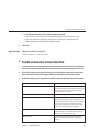
JNDI Resources
The Java Naming and Directory Interface (JNDI) is an application programming interface
(API) for accessing dierent kinds of naming and directory services. Java EE components locate
objects by invoking the JNDI lookup method.
JNDI is the acronym for the Java Naming and Directory Interface API. By making calls to this
API, applications locate resources and other program objects. A resource is a program object
that provides connections to systems, such as database servers and messaging systems. (A JDBC
resource is sometimes referred to as a data source.) Each resource object is identied by a
unique, people-friendly name, called the JNDI name. A resource object and its JNDI name are
bound together by the naming and directory service, which is included with the Enterprise
Server. To create a new resource, a new name-object binding is entered into the JNDI.
This section covers the following topics:
■
“Java EE Naming Services” on page 77
■
“Naming References and Binding Information” on page 78
■
“Using Custom Resources” on page 79
■
“Using External JNDI Repositories and Resources” on page 79
Java EE Naming Services
A JNDI name is a people-friendly name for an object. These names are bound to their objects by
the naming and directory service that is provided by a Java EE server. Because Java EE
components access this service through the JNDI API, the object usually uses its JNDI name.
When it starts up, the Enterprise Server reads information from the conguration le and
automatically adds JNDI database names to the name space.
Java EE application clients, enterprise beans, and web components are required to have access
to a JNDI naming environment.
The application component's naming environment is a mechanism that allows customization
of the application component's business logic during deployment or assembly. Use of the
6
CHAPTER 6
77


















